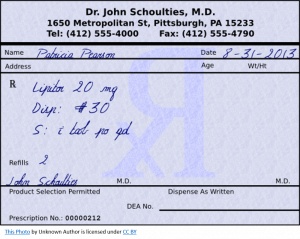9 Formatting Medications in Medical Reports

Lists of Medications
If the patient has more than 1 medication, transcribe medications in a numbered, vertical list, even when dosages have not been dictated.
Example:
MEDICATIONS:
-
- Aspirin 80 mg.
- Zolmitriptan 2.5 mg.
- Fluoxetine 60 mg.
If the voice file starts the medications section like a sentence (example: “The discharge medications include…“) change this. Instead, type the heading DISCHARGE MEDICATIONS with the medications in a vertical, numbered list right beneath the heading.
Allergies
Allergies: allergies to medications should be typed in all caps two spaces after the heading.
Examples:
ALLERGIES: IBUPROFEN.
ALLERGIES: Skin rash to PENICILLIN. (Gilmore, 2014, pp. xxi-xxii)
Abbreviations
NEVER abbreviate names of medications, but you can use abbreviations with medication instructions.
Common latin abbreviations used with medication instructions: (for more abbreviations, please click here)
| Abbreviation | Definition | Dangerous/DO NOT USE ??? |
| a.c. | before meals | |
| b.i.d. | twice a day | |
| h. | hour | |
| h.s. | at bedtime | YES |
| n.p.o. | nothing by mouth | |
| n.r. | do not repeat | |
| o.d. | once daily | YES |
| p.c. | after meals | |
| p.o. | by mouth | |
| p.r.n. | as needed | |
| q. | every | |
| q.a.m. | every morning | |
| q.d. | every day | YES |
| q.4 h. | every 4 hours | |
| q.h.s. | nightly at bedtime | YES |
| q.i.d. | 4 times a day | |
| q.o.d. | every other day | YES |
| t.i.d. | 3 times a day | |
| u.d. | as directed | YES |
Physical forms of medications and also routes of administration remain abbreviated if they were abbreviated in the voice file or original report.
| Forms of Medications | Accepted Abbreviations |
| ampule | amp |
| capsule | cap |
| cream | cr, crm |
| liquid/syrup/spray/foam/tincture | – |
| lotion | – |
| ointment | – |
| pellet/bead | – |
| powder | – |
| suppository | supp |
| suspension and emulsion | susp and emuls |
| tablet | tab |
| Routes of Administration | Accepted Abbreviations |
| endotracheal | ET |
| inhalation | – |
| intra-arterial | – |
| intra-articular | – |
| intracardiac | – |
| intradermal | – |
| intramuscular | IM |
| intranasal | IN |
| intrathecal | – |
| intravenous | IV |
| oral | PO, p.o. |
| parenteral | – |
| rectal | PR (per rectum) |
| subcutaneous | subcu |
| sublingual | SL |
| topical | top. |
| transdermal (example, nicotine patch) | TD |
| umbilical | – |
| vaginal | vag or PV (per vagina) |
Dose versus Dosage
Dose represents quantity of drug to be administered AT ONE TIME.
Example: Amoxil 500 mg.
Dosage represents the REGIMEN of the drug, which is expressed in quantity per unit of time.
Example: Amoxil 500 mg b.i.d.
Use the word ‘for’ instead of ‘times’ when transcribing medication dosages
Example:
Voice file says, “Augmentin 500 mg b.i.d. times 9 days.” Transcribe “Augmentin 500 mg b.i.d. for 9 days.”
Use Latin abbreviations for expressing drug dosages.
Do NOT translate these abbreviations into English unless they are on ISMP’S ERROR-PRONE ABBREVIATIONS LIST and do NOT mix Latin with English.
Example: q.6 hours is wrong. It should be q.6 h.
Quantity of Pills Dispensed
All these formats are correct:
#40
Disp. #40
dispense #40
40 tablets
40 tabs
Examples:
Tylenol #3 for pain, 40 tablets. (in this case, it is clearer to use ’40 tablets’ than #40!!)
Celexa 20 mg daily, #90, refill given.
Medications and Punctuation
Mixtures of medications are expressed like this:
Example: Humulin insulin 70/30.
Do NOT use commas in between a drug name, its dosage, and its instructions, unless they are required to ensure clarity
Examples:
Acetaminophen 500 mg p.o. t.i.d. for pain. (no comma needed)
Humulin insulin 70/30, 15 units before breakfast and 15 units before dinner. (need a comma in between numbers to avoid confusion)
Tylenol #3 one tablet p.o. q.4 h. p.r.n. pain.
References
Anderson, L. A., & Drugs.com. (2019, July 17). Medical Abbreviations on Pharmacy Prescriptions. Retrieved September 2020, from Drugs.com: https://www.drugs.com/article/prescription-abbreviations.html
Gilmore, D. M. (2014). Medical Transcription Projects. Stamford, Connecticut, United States of America: Cengage Learning.
Sims, L. M. (2008). The Book of Style for Medical Transcription (3rd ed.). Modesto, California, United States of America: Association for Healthcare Documentation Integrity.
Via the ET tube
Directly into the joint space.
Into the nose
Into the thecal sac, which is the meninges that surround and protect the spinal cord.
Administered into a person through a non-gastrointestinal route. For example: intravenous or intramuscular.
Under the tongue
Specific instructions on how the drug is to be taken (route of administration, frequency, with or without food, and time of day).


Feedback/Errata